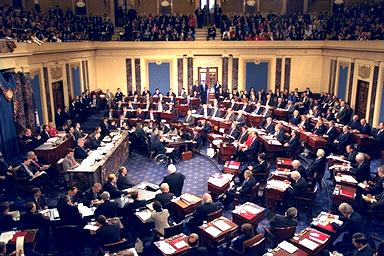 Two weeks ago, an expected milestone of sorts in the debate over chemical policy seemed to turn abruptly into a headstone. Senators Vitter and Udall were expected to release a revised version of their Chemical Safety Improvement Act (CSIA) that responded to many of the concerns of health and environment leaders from across the country. Senator Boxer, the committee chairwoman, was expected to release her own “redline” of that proposal that would go further in addressing concerns, including many of her own. The dual releases were expected to showcase the progress that had been made on the issue of reform and a narrowing of the gap between both sides.
Two weeks ago, an expected milestone of sorts in the debate over chemical policy seemed to turn abruptly into a headstone. Senators Vitter and Udall were expected to release a revised version of their Chemical Safety Improvement Act (CSIA) that responded to many of the concerns of health and environment leaders from across the country. Senator Boxer, the committee chairwoman, was expected to release her own “redline” of that proposal that would go further in addressing concerns, including many of her own. The dual releases were expected to showcase the progress that had been made on the issue of reform and a narrowing of the gap between both sides.
Instead, at the 11th hour, Senator Vitter disowned the draft he and Senator Udall had been circulating, citing a lack of additional Democratic support. He declared the end of negotiations for the year and announced he would go back to the introduced version of his bill. (Senator Udall, by contrast, is sticking by the proposed revisions.) Senator Boxer went ahead and released her own proposal anyway, which she has described as not a final offer. As it stands, only Senator Vitter has declared an end to negotiations.
So is TSCA reform dead?
I don’t think so. The issues are still the issues and the interests are still the interests. Both sides have moved substantially from their initial positions, and both drafts effectively reject the disastrous introduced version of the CSIA. The threat of going back to the CSIA as introduced is neither politically nor substantively credible, regardless of the mid-term election outcome.
And Safer Chemicals, Healthy Families continues to take the position that it has since the bill was introduced – that the CSIA could be the basis of negotiations for true chemical safety reform, but the bill as introduced was worse than current law and a threat to public health. We’ve spelled out possible fixes in some detail and shared them widely.
So where are we now?
To her credit, Senator Boxer was one of the few Senators to correctly size up the substantive problems with the CSIA right off the bat. She slowed the rush to judgment on the bill and gave outside experts the breathing room we needed to look it over and weigh in. She also highlighted the mainstream health and environmental critique in a public hearing. Given the lobbying and PR juggernaut behind the bill in its first few weeks this stance was politically gutsy as well as substantively accurate. Senator Udall, to his credit, stepped into the role of the late Senator Lautenberg on the bill and vowed to work on improvements to address the concerns. Senator Vitter, to his credit, agreed to negotiate over the issues too. Plenty of credit to go around.
Over the last year, Senators Vitter and Udall continued to work on improvements to their own bill, both bi-laterally and eventually with Senator Boxer. In the spring they presented her with a revised version of the bill. She then provided them with a redline of their draft. They responded to her revisions with the draft that circulated widely on the Hill and with key stakeholders – including us – in recent weeks. The version Senator Boxer released is her response to that draft. The point is: they had all been negotiating for months. And furthermore, they made some real progress. How do we know? Look at Senator Boxer’s draft.
 In her draft, Senator Boxer accepts some of the revisions from Vitter-Udall (now just Udall) and adds many of her own. She also makes several serious concessions to them and to the interests of the chemical industry. Anyone who is serious about TSCA reform should dig into the Boxer proposal and grapple with its content. She will either be the Chair or the Ranking Member next year and she has now put her own moderate proposal on the table.
In her draft, Senator Boxer accepts some of the revisions from Vitter-Udall (now just Udall) and adds many of her own. She also makes several serious concessions to them and to the interests of the chemical industry. Anyone who is serious about TSCA reform should dig into the Boxer proposal and grapple with its content. She will either be the Chair or the Ranking Member next year and she has now put her own moderate proposal on the table.
So what’s in Boxer’s draft?
Senator Boxer has taken the basic framework of the CSIA – with high and low priority chemicals – and fixed it. There is a modest but achievable and enforceable schedule for reviewing and restricting high priority chemicals. The low priority category no longer has the potential for hiding thousands of chemicals from state and federal review based on scanty information. Hers is the first draft to spell out a funding mechanism for the program, which everyone has agreed in theory is needed, but no one else has put forward.
Senator Boxer has added a provision for expedited action for a relatively small number of the worst of the worst chemicals, including asbestos. Asbestos! It should be a no-brainer. And the other chemicals targeted here are persistent, bio-accumulative, and toxic chemicals, or PBTs. This is a class of chemicals targeted by the Stockholm Convention, a treaty signed by President George W. Bush. These ideas are thoroughly in the global mainstream.
In a major concession, Senator Boxer does not propose minimum information requirements for chemicals, instead settling for improved testing authority for EPA. Minimum data sets are another mainstream provision in Europe and in our own pesticide law, but they have been steadfastly opposed by the chemical industry for TSCA.
Senator Boxer has picked up and improved upon the revised provisions for confidential business information in the circulated draft. Pointedly, she has agreed to allow chemical identity to be kept secret in certain circumstances. For a longtime champion of right-to-know, this is a major concession.
Senator Boxer has proposed using the same safety standard for chemicals that is used for pesticides. It’s a health-based standard that protects pregnant women and children and requires that known exposures are aggregated to get an accurate picture of the dose that people receive. This is the approach endorsed by the American Academy of Pediatrics in its own authoritative policy statement. However, in a concession to industry, Senator Boxer’s draft allows for consideration of costs in choosing which risk management measures are needed to ensure that the standard is met.
Finally, Senator Boxer proposes to allow states to develop and implement their own chemical policies as long as they adhere to, or go beyond, the federal requirement, as is the case with most major environmental laws. Some in industry and Congress will cite this stance as a justification for dismissing the whole proposal. That would be a mistake.
In addition to the changes I’ve enumerated, there are a number of others Senator Boxer has made – and others that the Udall draft proposed – that are worthy and deserve scrutiny. Senator Boxer has made clear her draft is not a final offer. Hard bargaining over the remaining issues is the only path forward.
As I noted in a previous blog, the chemical industry categorically attacked and dismissed the House Democratic proposal on TSCA at the exact moment that bargaining between the House Republicans and Democrats would have moved the debate forward. They did this even though the House Democratic draft used the industry framework on the safety standard and explicitly invited a negotiation over the role of states. Let’s hope they don’t make the same mistake again.
Many Senators who have closely monitored this debate have appropriately encouraged negotiations, but more importantly they have avoided endorsing any bill until it provides a clear benefit for public health and the environment. That approach should be applauded. TSCA reform is fundamentally about identifying and restricting the chemicals that cause cancer, birth defects, learning disabilities, and a host of other health problems that affect millions of American families. If the chemical industry and its allies hold out for a version of reform that is more about restricting states than it is about restricting chemicals, they won’t get it.
Safer Chemicals, Healthy Families is at the table to achieve honest reform. It’s the only version of reform worth waiting for.




